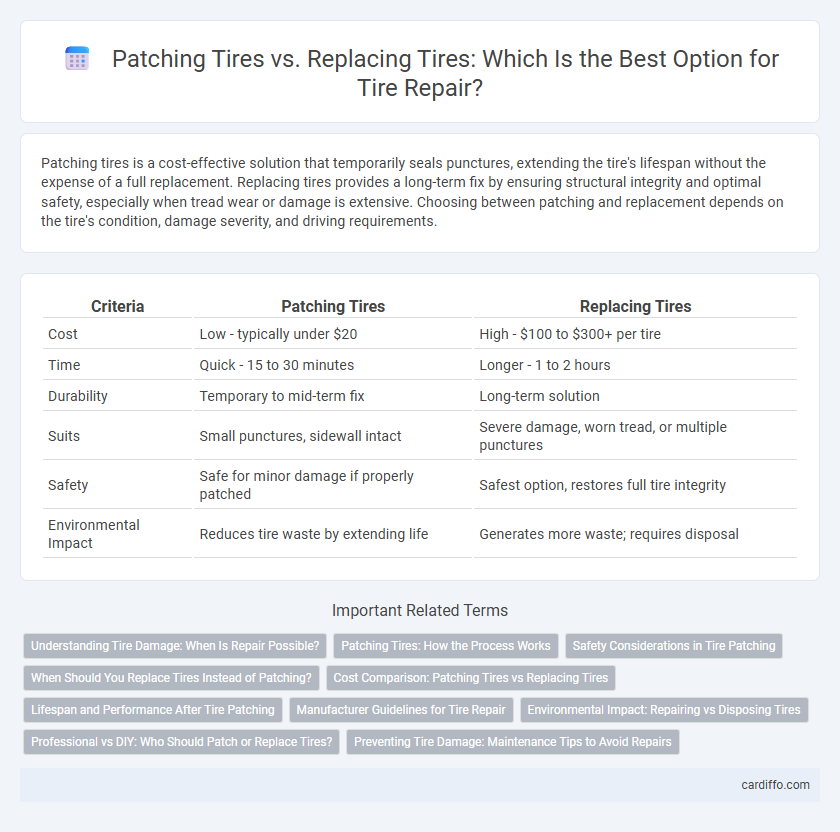Patching tires is a cost-effective solution that temporarily seals punctures, extending the tire's lifespan without the expense of a full replacement. Replacing tires provides a long-term fix by ensuring structural integrity and optimal safety, especially when tread wear or damage is extensive. Choosing between patching and replacement depends on the tire's condition, damage severity, and driving requirements.
Table of Comparison
| Criteria | Patching Tires | Replacing Tires |
|---|---|---|
| Cost | Low - typically under $20 | High - $100 to $300+ per tire |
| Time | Quick - 15 to 30 minutes | Longer - 1 to 2 hours |
| Durability | Temporary to mid-term fix | Long-term solution |
| Suits | Small punctures, sidewall intact | Severe damage, worn tread, or multiple punctures |
| Safety | Safe for minor damage if properly patched | Safest option, restores full tire integrity |
| Environmental Impact | Reduces tire waste by extending life | Generates more waste; requires disposal |
Understanding Tire Damage: When Is Repair Possible?
Tire repair is feasible when damage is limited to small punctures in the tread area measuring less than 1/4 inch in diameter, without sidewall involvement or structural compromise. Extensive cuts, sidewall damage, or large holes compromise tire integrity, necessitating full replacement to maintain safety and performance. Accurate assessment using tire inspection tools and professional evaluation ensures proper decision-making between patching and replacing tires.
Patching Tires: How the Process Works
Patching tires involves removing the tire from the rim to identify and properly seal punctures from the inside, ensuring an airtight repair. This process requires cleaning and buffing the damaged area, applying a vulcanizing adhesive, and then placing a rubber patch that bonds securely to the tire's inner surface. Properly patched tires restore structural integrity and prevent air leaks, extending tire life without the need for full replacement.
Safety Considerations in Tire Patching
Patching tires can restore tire integrity for small punctures, but safety considerations limit its use to areas within the tread, avoiding sidewall damage that compromises tire strength. Properly patched tires maintain proper air pressure and prevent blowouts, but replacing tires is essential when damage exceeds repair guidelines to ensure optimal traction and handling. Tire manufacturers and safety standards consistently recommend replacement if the patch size is too large or the tire exhibits sidewall or shoulder damage, prioritizing driver safety.
When Should You Replace Tires Instead of Patching?
Replace tires instead of patching when the damage exceeds 1/4 inch in diameter, occurs on the sidewall, or the tire has multiple punctures that compromise its structural integrity. Tires with significant tread wear below 2/32 inch also require replacement for safety reasons, as patching cannot restore adequate traction. Choosing replacement ensures reliable performance and prevents potential blowouts, maintaining vehicle safety.
Cost Comparison: Patching Tires vs Replacing Tires
Patching tires typically costs between $10 and $30 per tire, offering a budget-friendly solution for minor punctures and extending tire life. Replacing tires, however, can range from $100 to $300 or more per tire depending on brand and specifications, representing a higher upfront investment but ensuring optimal safety and performance. Evaluating the extent of tire damage and tread wear is essential to determine whether patching or full replacement provides the best cost efficiency over time.
Lifespan and Performance After Tire Patching
Tire patching extends the lifespan of a tire by addressing punctures without compromising the tire's structural integrity if done correctly, allowing continued reliable performance. However, patched tires typically offer reduced performance compared to new tires, especially under high-speed or heavy-load conditions, due to potential weakened areas. Replacing tires ensures optimal grip, safety, and longevity, particularly when tread wear or damage exceeds repairable limits.
Manufacturer Guidelines for Tire Repair
Manufacturer guidelines for tire repair emphasize that patching is appropriate only for minor punctures located within the tread area and not exceeding specific size limits, typically 1/4 inch or 6 mm. Tires with sidewall damage, extensive wear, or punctures beyond the allowed size must be replaced to ensure safety and performance. Adhering strictly to these manufacturer recommendations prevents compromised tire integrity and potential failure.
Environmental Impact: Repairing vs Disposing Tires
Patching tires significantly reduces environmental impact by minimizing rubber waste that typically ends up in landfills or incinerators, where it can release harmful chemicals. Repairing extends the lifespan of tires, lowering the demand for new tire production, which involves energy-intensive processes and raw material extraction. Disposing of tires contributes to pollution and resource depletion, making tire patching a more sustainable option for managing tire longevity.
Professional vs DIY: Who Should Patch or Replace Tires?
Professional tire patching ensures proper sealing and safety due to advanced tools and expertise, reducing risks of blowouts compared to DIY repairs. DIY patching suits minor punctures but lacks the precision to assess internal damage or tire integrity, which professionals evaluate before recommending replacement. Ultimately, severe tire damage or sidewall punctures necessitate replacing tires to guarantee optimal performance and road safety.
Preventing Tire Damage: Maintenance Tips to Avoid Repairs
Regularly inspecting tire tread depth and maintaining proper air pressure are critical steps in preventing tire damage and extending tire lifespan. Rotating tires every 6,000 to 8,000 miles ensures even wear, reducing the need for frequent repairs. Avoiding overloading the vehicle and promptly addressing minor punctures with patching can prevent more severe tire issues and costly replacements.
patching tires vs replacing tires Infographic

 cardiffo.com
cardiffo.com